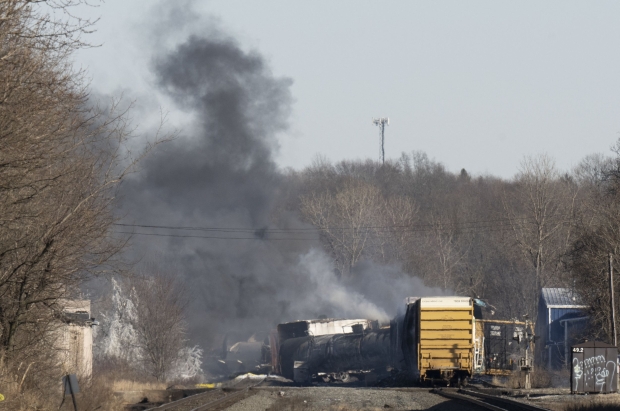Months-Long Persistence Of Toxic Chemicals After Ohio Derailment

Table of Contents
Types of Toxic Chemicals and Their Persistence
The Ohio derailment released a cocktail of hazardous chemicals, many known for their persistence in the environment. Key culprits include vinyl chloride, a known carcinogen, and butyl acrylate, an irritant and potential respiratory hazard. These chemicals possess properties that contribute to their long-term presence in soil and water.
-
Chemical Properties: Vinyl chloride's volatility allows it to evaporate readily, but it can also persist in soil and groundwater, especially in anaerobic conditions. Butyl acrylate, while less volatile, is highly soluble in water, leading to potential widespread contamination of water sources.
-
Persistence and Bioaccumulation: The half-life of these chemicals varies, with vinyl chloride degrading relatively quickly under aerobic conditions, while butyl acrylate's persistence is influenced by several factors including temperature and pH. However, the concern lies not only in their direct persistence but also their potential for bioaccumulation in the food chain, posing risks to wildlife and potentially humans consuming contaminated food or water.
-
Detection and Removal Challenges: Detecting and removing these chemicals from the environment is incredibly complex. The diverse chemical composition and the spread of contamination across varied terrains (soil types, water bodies) necessitate sophisticated monitoring techniques and tailored remediation strategies, adding to the complexity and duration of the cleanup process.
Impact on Water Sources and Contamination Levels
The derailment significantly impacted local water sources. Nearby waterways, including Sulphur Run and Leslie Run, experienced immediate contamination. Private wells have also shown signs of contamination, raising concerns about the long-term safety of drinking water supplies.
-
Contamination Levels: Initial tests revealed elevated levels of vinyl chloride and other contaminants in water samples collected downstream from the derailment site. The extent of contamination and its spatial distribution remain a subject of ongoing investigation and monitoring.
-
Long-Term Effects: Continued water contamination poses several long-term risks. These include potential health issues from ingesting contaminated water, as well as harm to aquatic ecosystems through the disruption of delicate aquatic life balances.
-
Water Testing and Monitoring: Ongoing water testing and monitoring are crucial to assess the long-term impacts and guide cleanup efforts. However, inconsistencies in testing methodologies and the lack of publicly available, comprehensive data raise further concerns about the transparency and effectiveness of these efforts.
Soil Contamination and its Long-Term Consequences
The chemicals released have infiltrated the soil, posing significant threats to the local ecosystem and agriculture. The extent of soil contamination is still being assessed, but early indications suggest widespread impact.
-
Groundwater Leaching: A major concern is the potential for leaching of contaminants into groundwater, which can contaminate drinking water sources over the long term. This makes it vital to constantly monitor groundwater tables for chemical contamination.
-
Risks to Plant and Wildlife: Soil contamination can severely impact plant growth, leading to crop failure and damage to the wider ecosystem. Soil ingestion by animals can cause health problems, impacting the food chain.
-
Soil Remediation Challenges: Cleaning up contaminated soil is a lengthy and costly process. Effective remediation strategies require a deep understanding of the chemical properties of the contaminants and the specific soil conditions to achieve a meaningful degree of soil remediation.
Health Concerns and Impacts on the Community
Residents in the affected area have reported a range of health problems following the derailment, including headaches, respiratory issues, and skin irritations. The long-term health consequences of exposure to these chemicals are a major concern.
-
Reported Symptoms: Symptoms reported range from mild irritation to more serious respiratory problems. The long-term effects of exposure to low levels of these chemicals over an extended period are largely unknown, needing continuous monitoring and research.
-
Potential Long-Term Illnesses: Exposure to vinyl chloride, for instance, is linked to an increased risk of several cancers. The long-term health impacts on the community remain a serious concern, demanding sustained epidemiological studies.
-
Health Monitoring and Support: Ongoing health monitoring and support programs are essential to assess the long-term effects and provide appropriate medical care to affected residents. The establishment of transparent and accessible health resources is critical for building community trust.
Government Response and Cleanup Efforts
The government's response to the derailment and subsequent cleanup efforts have faced considerable criticism. While cleanup activities have been underway, concerns remain about their speed, effectiveness, and transparency.
-
Adequacy of Response: Questions about the initial response and the adequacy of early communication with the community have been raised. The timing and scope of the cleanup efforts continue to be contested.
-
Effectiveness of Remediation Strategies: The effectiveness of the cleanup strategies employed is still under evaluation. Comprehensive long-term monitoring will be needed to ensure effective remediation of affected areas.
-
Criticisms and Ongoing Concerns: Criticisms center on the transparency of information released to the public, the perceived slow pace of cleanup, and the lack of comprehensive long-term health monitoring for residents.
Conclusion
The months-long persistence of toxic chemicals following the Ohio train derailment highlights the devastating and long-lasting consequences of industrial accidents. The contamination of water sources, soil, and the potential for long-term health problems underscore the urgent need for comprehensive and effective cleanup strategies, and a complete and transparent investigation into the long-term effects. Further investigation and transparent communication are crucial to address community concerns and ensure public safety.
Call to Action: The lingering effects of the Ohio derailment demand continued vigilance and action. Learn more about the ongoing impact of these toxic chemicals and demand accountability for preventing future disasters. Stay informed about the latest developments and advocate for comprehensive environmental protection measures to prevent similar tragedies. Demand further investigation into the long-term effects of the Ohio derailment and support initiatives promoting toxic chemical safety.

Featured Posts
-
 Perspektivy Ekonomicheskogo Partnerstva Mezhdu Rossiey I Chekhiey
May 02, 2025
Perspektivy Ekonomicheskogo Partnerstva Mezhdu Rossiey I Chekhiey
May 02, 2025 -
 Examining Maines Inaugural Post Election Audit
May 02, 2025
Examining Maines Inaugural Post Election Audit
May 02, 2025 -
 Fortnite Update 34 40 Servers Offline For Maintenance
May 02, 2025
Fortnite Update 34 40 Servers Offline For Maintenance
May 02, 2025 -
 New Insights Into Rarely Seen Seabirds Research By Te Ipukarea Society
May 02, 2025
New Insights Into Rarely Seen Seabirds Research By Te Ipukarea Society
May 02, 2025 -
 Kashmir Cat Owners Respond To Worrying Online Trends
May 02, 2025
Kashmir Cat Owners Respond To Worrying Online Trends
May 02, 2025
Latest Posts
-
 Gaza Freedom Flotilla Sos Drone Attack Reported Off Malta
May 03, 2025
Gaza Freedom Flotilla Sos Drone Attack Reported Off Malta
May 03, 2025 -
 Arsenals Champions League Hopes Under Threat Sounesss Assessment
May 03, 2025
Arsenals Champions League Hopes Under Threat Sounesss Assessment
May 03, 2025 -
 The Missing Piece Souness On Arsenals Premier League Bid
May 03, 2025
The Missing Piece Souness On Arsenals Premier League Bid
May 03, 2025 -
 Souness Explains The Crucial Error That Cost Arsenal The Championship
May 03, 2025
Souness Explains The Crucial Error That Cost Arsenal The Championship
May 03, 2025 -
 Arsenals Title Failure Souness Pinpoints The Culprit
May 03, 2025
Arsenals Title Failure Souness Pinpoints The Culprit
May 03, 2025
